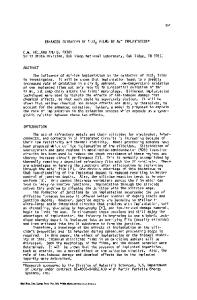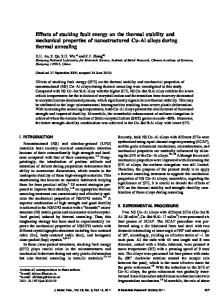Effects of an interposed Cu layer on the enhanced thermal stability of C49 TiSi 2
- PDF / 619,157 Bytes
- 5 Pages / 612 x 792 pts (letter) Page_size
- 57 Downloads / 372 Views
F.M. Pan National Nanodevice Laboratory, Hsinchu, Taiwan 300, Republic of China (Received 15 May 2001; accepted 10 November 2001)
The effects of an interposed Cu layer and a surface Cu layer on the C49–C54 TiSi2 transformation temperature were studied. For the Ti/Cu/(100)Si samples the interposed Cu layer significantly enhanced the thermal stability of C49 TiSi2. The temperature for complete C49–C54 TiSi2 transformation was raised from 710 to 735 to 750 °C with the thickness of the interposed Cu layer increasing from 0 to 1.5 to 3.5 nm, correspondingly. Cu was insoluble in C54 TiSi2. For the Cu/Ti/(100)Si samples, the surface Cu layer did not at all enhance the thermal stability of the C49 phase. In the present study, the enhanced thermal stability of C49 TiCuxSi2−x can be attributed to its reduced electron/atom ratio and larger grain size relative to those of C49 TiSi2.
I. INTRODUCTION
TiSi2 has been widely used for ohmic contacts and gate electrodes in ultralarge-scale integration (ULSI) devices because of its low resistivity, good thermal properties, and compatibility with the self-aligned silicidation process. TiSi2 may exist either as the high-resistivity C49 phase or as the low-resistivity C54 phase.1 For device applications, the C54 TiSi2 is preferred because of its low resistivity. The C49 phase generally forms first at temperatures ranging from 550 to 700 °C and then transforms to the C54 phase at temperatures above 700 °C. The morphological stability of the C54 phase during high-temperature annealing is crucial to the development of ULSI technology.2 Recently, it has been shown that the C49–C54 transformation temperature can be lowered by preamorphization of Si substrates before Ti deposition,3–5 ion implantation of Mo or W into Si substrates before Ti deposition,6,7 and deposition of an interposed layer of refractory metals or alloys between the Ti film and Si substrate.8–15 The enhanced formation of the C54 phase by preamorphization of Si substrates or Mo ion implantation or interposition of a Mo layer may be attributed to the increased nucleation sites of the triple junctions in the C49 phase.5,10,15,16 The enhanced growth of the C54 phase by interposition of a refractory metal layer may also be explained as due to the formation of the C40 phase or Ti5Si3, which acts as a template for the growth a)
II. EXPERIMENTAL PROCEDURES
Si(2 nm)/Ti(25 nm)/Cu(1.5 nm)/Ti(2 nm) and Si(2 nm)/ Ti(25 nm)/Cu(3.5 nm)/Ti(2 nm) multilayers were deposited onto the (100) Si substrates, hereafter referred to
e-mail: [email protected] J. Mater. Res., Vol. 17, No. 2, Feb 2002
http://journals.cambridge.org
of the C54 phase.7–9,12–14 Recently, it has been reported that the electron/atom ratio may play an important role in determining the phase stability of TiSi2.17–19 When the electron/atom ratio is increased, the stable phase changes from C49 to C54 to C40. Typical examples include the enhanced thermal stability of C49 TiSi2 in the presence of Al or Sc with fewer valence electrons and the enhanced formation of C54 T
Data Loading...










